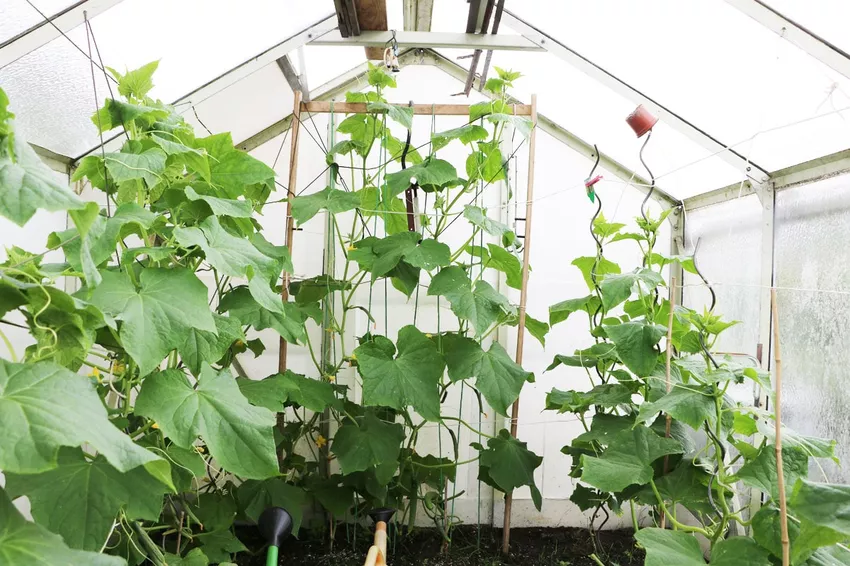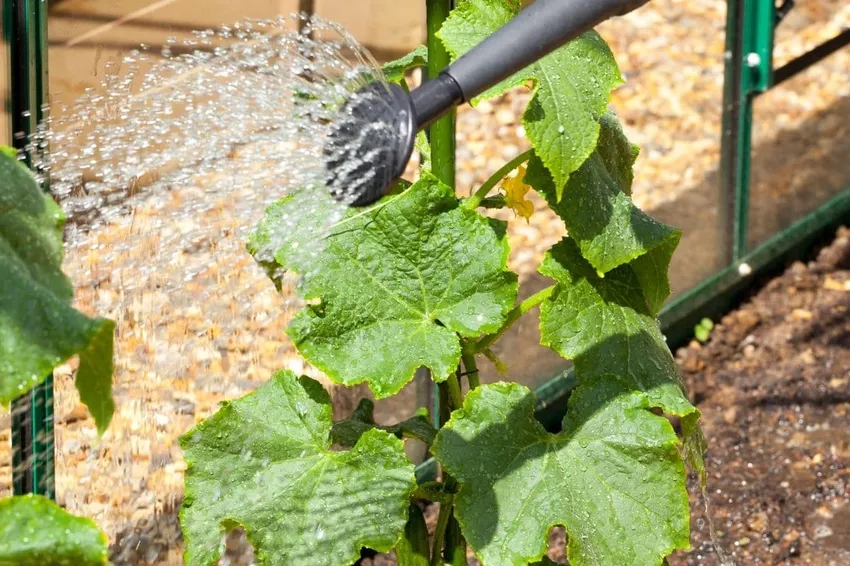
Sometimes, for various reasons, cucumbers simply die. Read here what causes are often behind it and what measures can be taken to counteract it. Here's how to save your cucumbers.
In a nutshell
- Cucumber plants are delicate plants
- usually external influences are responsible for the death
- rare maintenance error
- Know the causes and initiate measures
- in many cases the cucumbers can be saved
Cucumbers are dying: causes
If your cucumbers suddenly die, there are various possible causes:
state of exhaustion
The sudden death of cucumbers can be due to a state of exhaustion. Usually young plants are affected, in which at the latest after the second harvest-ready cucumber an undersupply leads to exhaustion. This is due to the supply channels that have not yet fully developed and the nutrient storage capacity being too low.
Typical damage
- growth disorders
- Loss of stability due to lack of energy
- Withering of the green and the fruit
- desiccation
countermeasures
 Dried cucumber leaf
Dried cucumber leaf
- Cut off dried leaves as soon as possible (unnecessarily remove nutrients)
- Give vegetable fertilizer
- pour with field horsetail stock to strengthen
Prepare and use horsetail stock
- Add 1 to 1.5 kilograms of fresh, finely chopped or 150 to 200 grams of dried field horsetail to ten liters of water
- Leave for 24 hours
- Bring the broth to the boil and cook for 30 minutes
- Let cool and sieve out leftovers
- Pour broth on plants
- Repeat every two to three days for two weeks
prevention
- Delay fruit growth in the first two years of life
- remove all but one of adjacent leaf axils if fruit is growing at the same time
- fertilize regularly with nutrients
- pay attention to ideal soil properties
blossom end rot
In the case of blossom end rot, there is usually a physiological calcium deficiency.
Typical damage
 Blossom end rot on tomatoes
Blossom end rot on tomatoes
- small, watery spots at the base of the flowers
- visible spread of rot on fruits (mostly affected in early ripening stage)
- increasingly large black-brown spots on affected cucumber (sunken)
- Fruits dry and harden
countermeasures
First, the soil should be checked for pH. If this is below 6.0, algae lime should be worked into the soil in the event of an acute infestation. So that it dissolves quickly, it should be watered afterwards. If the pH value is in the ideal range, the cause may be excessive salt content in the soil. Over-fertilization is often to blame here. Salt prevents the plant from absorbing calcium. In this case, the best help is to completely replace the soil with fresh soil to lower the fertilizer content. Areas badly affected by rot should be cut off. If you act quickly and consistently, your cucumbers will not inevitably die.
Tip: There are one-time tests for determining the pH value in gardening shops and most well-stocked hardware stores. Anyone who likes to garden a lot should always have these at home so that they are quickly to hand when needed.
prevention
The best countermeasure is prevention. This looks like this:
- When dosing, comply with the manufacturer's instructions or dose lower
- water evenly and regularly and prevent over and under moisture
- Pay attention to air permeability to avoid high humidity
- provide loose, well-drained soil
anthracnose
Anthracnose is a widespread disease caused by a fungal pathogen (Colletotricum lupini). If you don't pay close attention to the damage, you can quickly confuse the fungal disease with blossom end rot and the associated calcium deficiency. Here, too, it is important to act quickly, otherwise the cucumbers will die.
Typical damage
 Anthracnose on cucumbers
Anthracnose on cucumbers
- dark gray to brown sunken burning spots (lesions) on fruits
- dark spots if the ambient air is dry, formation of a salmon-colored carpet of spores if the air is humid
- falling fruit tissue in the later course
- fruits dry up
- Fruit buds wither and dry up
- Shrinkage of cucumbers in early ripening
- small light spots on leaves
- Desiccation of the entire plant in the final stage
countermeasures
- Cut off affected parts of the plant immediately and dispose of in organic waste
- be sure to disinfect the cutting tool afterwards
- Put the plant in a cooler place (ideally at 21 degrees Celsius)
- Pour field horsetail brew to strengthen the plants (for production and use, see "State of exhaustion - what to do about it"
Tip: Never dispose of plant parts with bacterial, viral or fungal pathogens in the compost. In the open air, these can spread undisturbed. They should always be disposed of under lock and key.
Angular leaf spot disease
The bacterium Xanthomonas fragariae triggers the angular leaf spot disease that commonly occurs in garden cucumbers. The bacterium does not form spores and is rod-shaped. Because it not only affects the leaves or outer parts of the plant, but also gets inside the plant, cucumbers can die quickly if countermeasures are not taken in good time.
Typical damage
 Angular leaf spot on strawberries
Angular leaf spot on strawberriesSources: Annemik M.C. Schilder, Disease severity on underside of leaf, Edited by Plantopedia, CC BY-SA 4.0 (left), Annemik M.C. Signs, Translucent spots, Edited by Plantopedia, CC BY-SA 4.0 (right)
- small, watery burn spots on undersides of leaves
- Spot enlargements in angular shapes with increasing progression
- formation of a viscous bacterial slime in a humid environment
- Spot colour: greenish, later brown
countermeasures
Regardless of when the bacterial infection is discovered and identified as such, there is unfortunately no help in this case. The entire plant should be disposed of with household or organic waste. For a period of at least three years, no more cucurbits, which include cucumbers, should be grown on the same planting site.
prevention
There is not much that can be done to prevent leaf spot disease. Experts suspect that a high warm-humid constellation promotes the disease, so an airy location can slightly reduce the risk. The avoidance of monoculture and constant crop rotation also reduces the risk.
Fusarium wilt
Fusarium wilt is common in cucumber plants. This is where the fungus settles Fusarium oxysporum the plant and ensures that the damage is easily recognizable.
Typical damage
 Fusarium wilt on strawberries
Fusarium wilt on strawberries
- rapid, premature wilting of flowers
- Buds don't open
- slowly progressing brown leaf colouration
- increasing dehydration
- growth disorders
- brown-black discoloration on fruits before they dry up
- complete desiccation of the plant
countermeasures
Nothing. So far there are no known effective measures against Fusarium wilt that could stop cucumbers from dying. Disposal is essential.
prevention
- Strengthen resilience with pesticides (e.g. water regularly with horsetail decoction)
- Lay drainage (to avoid waterlogging)
- only use disinfected cutting tools
- avoid monoculture
Strong temperature fluctuations
If there are significant temperature fluctuations and it cools down significantly in between, this can have a negative effect on cucumber plants. In the worst case, your cucumbers will die here too.
 A location in the greenhouse can protect cucumber plants from excessive temperature differences.
A location in the greenhouse can protect cucumber plants from excessive temperature differences.
Typical damage
- stunted cucumber forms
- dried young fruits
- premature fruit drop of unripe cucumbers
countermeasures
In the case of damage caused by strong temperature fluctuations, nothing else helps than throwing away the affected fruit.
prevention
As a preventative measure, cucumber plants can be planted in a wind-protected location, which, however, favors an infestation with leaf spot disease. It is advisable to check the weather forecast in order to protect the plants in good time with cold protection, such as fleece, in the event of a sharp drop in temperature.
lack of water
If your cucumbers are dying, a lack of water is often the reason. This is clearly a maintenance error that is easy to prevent. Recognized in time, the plant can be helped quickly.
Typical damage
- Plant loses stability
- further damage as described under "Severe temperature fluctuations".
 pour cucumbers
pour cucumbers
countermeasures
- water immediately
- Cut off dead plant parts
prevention
The only preventive measure is regular watering and checking the soil moisture twice a day, especially on hot summer days.
frequently asked Questions
Can cucumber aphids kill cucumbers?Usually not. Although lice are parasitic pests, when they infest healthy and vigorous cucumber plants, it is not usually a life-threatening situation.
How can you tell when a Cucumis sativus is about to die?The more cells die, the less photosynthesis works. If more than 3/4 of the cucumber plant has dried up, it is usually almost impossible to stop it from dying.
Are cucumbers still edible if they are not directly infected?Consumption is not recommended for the above-mentioned reasons. In almost every case, negative effects on the fruit can be expected. You should refrain from consuming them, especially if they are infected with fungi or bacteria, as this can result in damage to your health. Exceptions are, of course, temperature fluctuations and lack of water, although developmental disorders also cause changes in consistency, taste and degree of ripeness.